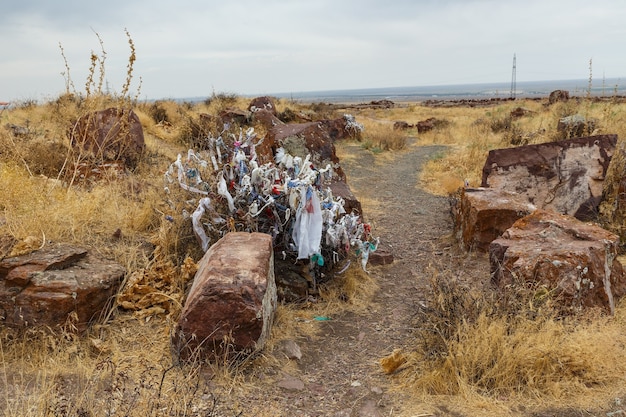Ethical Dilemmas: Unpacking the True Cost of Fast Fashion

Fast fashion’s ethical considerations encompass labor exploitation, environmental degradation, and unsustainable consumption practices, urging consumers to reconsider their purchasing habits for a more responsible approach.
The allure of affordable, trendy clothing is undeniable, but have you ever stopped to consider what are the ethical considerations of buying fast fashion? This industry, known for its rapid production cycles and low prices, often masks a darker side involving exploitation, environmental damage, and unsustainable practices that demand our attention.
What is Fast Fashion and Why is it Problematic?
Fast fashion refers to the rapid production of inexpensive clothing by mass-market retailers. These clothes are created quickly to capture current trends, allowing consumers to constantly update their wardrobes. However, this constant demand for newness comes at a significant cost.
From its impact on resources to the global economy, the fast fashion industry can be seen as a very problematic system of consumption.
Environmental Pollution
The environmental impact of fast fashion is staggering. The industry is a significant contributor to water pollution, with textile dyeing being a major culprit. Additionally, synthetic fabrics like polyester, which are commonly used in fast fashion, release microplastics into the environment when washed.
Waste Generation
Fast fashion also contributes heavily to landfill waste. The short lifespan of trendy items means that many garments are discarded after only a few wears. This leads to overflowing landfills and the release of harmful greenhouse gases as these materials decompose.
- Water pollution from textile dyeing.
- Microplastic pollution from synthetic fabrics.
- Landfill waste due to short garment lifespans.
- Greenhouse gas emissions from decomposing textiles.
Ultimately, the rapid turnover and disposal of fast fashion items create a significant environmental burden. Consumers need to be aware of these issues and consider the long-term impact of their purchasing decisions.

Labor Exploitation in Fast Fashion Supply Chains
One of the most critical ethical considerations of fast fashion is the treatment of garment workers. The industry’s demand for low prices often leads to exploitation and unsafe working conditions.
Workers are being treated unfairly in many different parts of the production chain. From cotton crops to factories, worker exploitation is a major issue in many fast fashion company’s supply chains.
Unsafe Working Environments
Many garment factories are located in developing countries, where labor laws are weak or poorly enforced. Workers often face long hours, low wages, and dangerous working conditions. Accidents and injuries are common, and workers may lack basic protections such as safety equipment and adequate ventilation.
Low Wages and Poverty
The pressure to keep prices low also results in inadequate wages for garment workers. Many earn barely enough to survive, trapping them in a cycle of poverty. This exploitation is a direct consequence of the fast fashion industry’s business model.
- Long hours and low wages for garment workers.
- Dangerous working conditions and lack of safety equipment.
- Weak labor laws and poor enforcement in developing countries.
- Poverty and exploitation as a result of low wages.
Addressing labor exploitation requires greater transparency and accountability throughout the supply chain. Consumers can also make a difference by supporting brands that prioritize fair labor practices. This will help to ensure decent work and dignified wages for garment workers.
The Impact on Consumers and Culture
Beyond the environmental and labor concerns, fast fashion also affects consumers and cultural values. The constant promotion of new trends encourages a culture of disposability and overconsumption.
The push to buy, use, and discard items quickly impacts individual consumers as well as their surrounding culture. These issues must be addressed in order to move forward.
Overconsumption and Disposability
Fast fashion fosters a mindset of overconsumption, where clothing is seen as disposable and easily replaceable. This constant cycle of buying and discarding contributes to environmental waste and promotes unsustainable habits.
Loss of Traditional Skills
The mass production of inexpensive clothing has also led to a decline in traditional sewing and crafting skills. As consumers increasingly rely on cheap, mass-produced garments, the value and appreciation for handmade and durable clothing diminishes.
- Promotion of overconsumption and disposability of clothing.
- Decline in traditional sewing and crafting skills.
- Erosion of cultural appreciation of handmade garments.
- Creation of unsustainable consumption habits.
To counteract these effects, consumers can embrace slow fashion principles, such as buying fewer items, choosing quality over quantity, and supporting local artisans and craftspeople. These choices promote a more sustainable and mindful approach to fashion. In doing so, individuals can limit their exposure to and impact on the fast fashion economy.

Animal Welfare Concerns in Fast Fashion
The ethical considerations of fast fashion extend to animal welfare. The industry’s demand for cheap materials often leads to inhumane treatment of animals.
Animals are often the subjects of abuse and mistreatment in order to meet the demands of the fast fashion industry.
Leather Production
The production of leather often involves cruel treatment of animals, including branding, tail docking, and confinement in small spaces. Additionally, the tanning process can release harmful chemicals into the environment.
Fur Farming
Fur farming is another area of concern, with animals often kept in cramped and unsanitary conditions before being killed for their fur. The use of fur in fast fashion contributes to animal suffering and environmental damage.
- Cruel treatment of animals in leather production.
- Harmful chemicals released during tanning.
- Inhumane conditions on fur farms.
- Animal suffering and environmental damage from fur use.
Consumers can choose to avoid products made from animal-derived materials and opt for vegan and cruelty-free alternatives. This reduces the demand for products that contribute to animal suffering and promotes ethical practices within the fashion industry. Furthermore, customers can support brands that make vegan clothing and other animal-free apparel.
The Role of Greenwashing in Fast Fashion
Greenwashing is a deceptive marketing tactic used by some fast fashion brands to portray themselves as environmentally friendly without making significant changes to their practices.
Many brands act in an insincere attempt to appear “green” or sustainable in an attempt to improve their image. This marketing ploys do little other than attempting to sway consumers and increase profits.
Misleading Claims
Brands may use terms like “eco-friendly” or “sustainable” without providing evidence to support these claims. This can mislead consumers into believing that they are making ethical choices when they are not.
Lack of Transparency
Greenwashing often involves a lack of transparency about the brand’s supply chain and production practices. This makes it difficult for consumers to assess the true environmental impact of their purchases.
- Use of misleading terms like “eco-friendly” without evidence.
- Lack of transparency about supply chain and production practices.
- Deceptive marketing tactics to portray brands as sustainable.
- Difficulty for consumers to assess true environmental impact.
To avoid falling for greenwashing, consumers should look for credible certifications and demand greater transparency from brands. Researching a company’s practices and policies can help consumers make informed choices and support truly sustainable brands. Supporting a company which values sustainability in the long run is a great way to combat negative effects.
What Can Consumers Do to Make Ethical Choices?
While the ethical considerations of fast fashion can seem overwhelming, there are many steps that consumers can take to make more responsible choices.
Ultimately, conscious consumerism is the way forward which ensures that you shop in the most ethical and sustainable ways possible.
Buy Less and Choose Quality
One of the most effective ways to combat the negative impacts of fast fashion is to buy fewer items and choose quality over quantity. Investing in durable, well-made garments that will last longer reduces the need for frequent replacements and contributes to a more sustainable wardrobe.
Support Sustainable Brands
Consumers can also support brands that prioritize ethical and environmental practices. Look for companies that are transparent about their supply chain, use sustainable materials, and treat their workers fairly. These brands are committed to making a positive impact on the planet and its people.
- Buying fewer items and choosing quality over quantity.
- Supporting brands that prioritize ethical and environmental practices.
- Opting for second-hand and vintage clothing.
- Recycling and upcycling old garments.
By making conscious choices and supporting ethical brands, consumers can play a significant role in transforming the fashion industry. This shift towards sustainability not only benefits the environment and garment workers but also promotes a more mindful and responsible approach to consumption.
| Key Point | Brief Description |
|---|---|
| 🏭 Labor Exploitation | Low wages and unsafe conditions for garment workers. |
| 🌎 Environmental Impact | Pollution, waste, and resource depletion from production. |
| 🐇 Animal Welfare | Cruel treatment in leather and fur production. |
| 🌱 Greenwashing | Misleading claims of sustainability by brands. |
Frequently Asked Questions
▼
Fast fashion is characterized by quickly producing trendy, inexpensive clothing in large quantities. These clothes are designed to capture current fashion trends and are sold at low prices to encourage frequent purchases.
▼
It leads to water pollution from textile dyeing, microplastic pollution from synthetic fabrics, and excessive landfill waste due to the short lifespan of garments. Additionally, it consumes significant resources and energy.
▼
Workers in fast fashion face long hours, low wages, and unsafe working conditions. Often, they are employed in developing countries with weak labor laws, leading to exploitation and a lack of basic protections.
▼
This is when fashion brands use misleading claims to portray themselves as environmentally friendly without making substantial changes. This can include using terms like “eco-friendly” without providing credible evidence or proof.
▼
Consumers can buy fewer items, choose quality over quantity, support sustainable brands, opt for second-hand clothing, and recycle or upcycle old garments. By making conscious choices, they can reduce their impact.
Conclusion
Understanding what are the ethical considerations of buying fast fashion is crucial for making informed and responsible consumer choices. By recognizing the environmental, social, and animal welfare implications of our purchasing decisions, we can actively contribute to a more sustainable and ethical fashion industry. Embracing conscious consumerism not only benefits the planet and its people but also fosters a deeper appreciation for the value of quality, durability, and fair labor practices.





